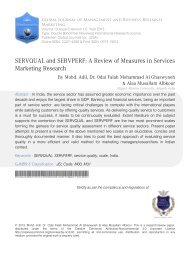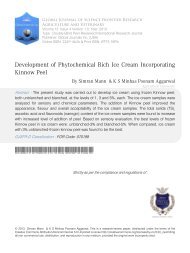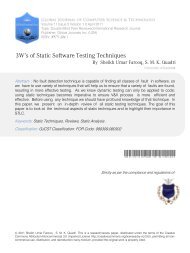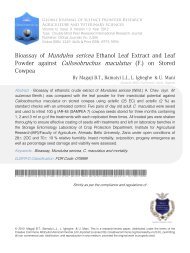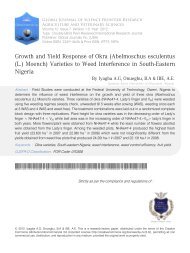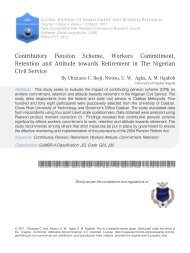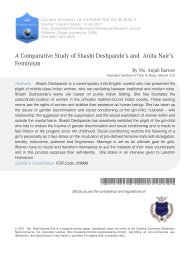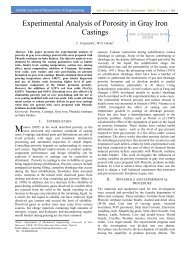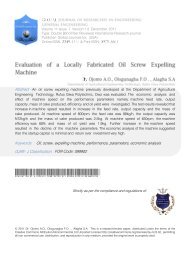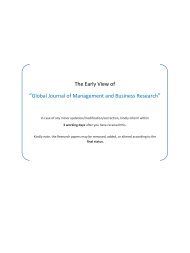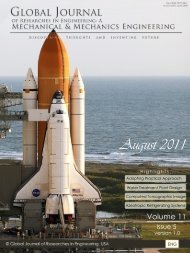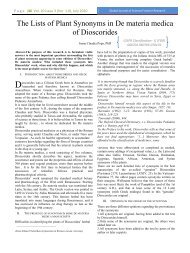Soil Colour as a Pedo-Transfer Function of Soil Organic Carbon and ...
Soil Colour as a Pedo-Transfer Function of Soil Organic Carbon and ...
Soil Colour as a Pedo-Transfer Function of Soil Organic Carbon and ...
Create successful ePaper yourself
Turn your PDF publications into a flip-book with our unique Google optimized e-Paper software.
d) <strong>Soil</strong> <strong>Colour</strong> Determination<br />
The soil colour (moist <strong>and</strong> dry) were determined<br />
by the use <strong>of</strong> the Munsell colour chart in which a soil is<br />
held next to the chips to find a visual match <strong>and</strong><br />
<strong>as</strong>signed the corresponding Munsell notation.<br />
III.<br />
a) Morphological Properties<br />
Results <strong>and</strong> Discussion<br />
i. <strong>Soil</strong> <strong>Colour</strong><br />
The soils <strong>of</strong> the l<strong>and</strong> use types were<br />
characterized by brown (5YR 5/4 – 10YR 6/4),<br />
s<strong>and</strong>yloam / loamys<strong>and</strong>, topsoil over reddish brown<br />
(2.5YR 4/8 – 7.5YR 6/8) s<strong>and</strong>y clayloam to s<strong>and</strong>y clay<br />
subsoil. The hue w<strong>as</strong> generally 10YR for lowl<strong>and</strong> arable<br />
soils, <strong>and</strong> 5YR to 7.5YR for the middle slope, while it<br />
ranges from 2.5YR to 7.5YR for the upl<strong>and</strong> section. The<br />
reverse w<strong>as</strong> the trend for l<strong>and</strong> use 2, with lowl<strong>and</strong><br />
portion having a hue <strong>of</strong> 5YR, while the middle portion<br />
ranges from 7.5YR to 10YR.<br />
However, in the secondary forest l<strong>and</strong> use type,<br />
both the middle <strong>and</strong> summit sections were<br />
characterized with 7.5YR hue, while the toes slope /<br />
valley bottom section ranges between 2.5YR to 7.5YR<br />
hue (Table 1).<br />
In addition, some sections <strong>of</strong> the valley bottom<br />
<strong>of</strong> both the arable <strong>and</strong> oil palm l<strong>and</strong> use types exhibited<br />
some level <strong>of</strong> mottling <strong>as</strong> evidence <strong>of</strong> water saturation at<br />
some period <strong>of</strong> the year.<br />
The colour difference showed that pedons on<br />
the crest <strong>and</strong> middle slopes were more reddish to<br />
brownish but greyish at the valley bottom. This variation<br />
in soil colour w<strong>as</strong> due to the obvious sequences <strong>of</strong><br />
drainage. This is in agreement with Noma et al., (2010).<br />
Besides, the influence <strong>of</strong> drainage on soil colour<br />
variation, it h<strong>as</strong> been reported by Majlis (1967) that soil<br />
colour h<strong>as</strong> been expressed too <strong>as</strong> a function <strong>of</strong> iron <strong>and</strong><br />
organic matter contents, pH <strong>and</strong> type <strong>of</strong> clay mineral in<br />
the soil.<br />
The fluctuating water table in the lower slope<br />
<strong>and</strong> valley bottom soils also resulted in the occurrence<br />
<strong>of</strong> hydromorphic mottles in these are<strong>as</strong>. The colours <strong>of</strong><br />
the studied soils vary with depth. This is in conformity<br />
with Brady <strong>and</strong> Well (1999), who reported that soil colour<br />
typically changes with depth through the various<br />
horizons in a soil pr<strong>of</strong>ile.<br />
ii. Physical Properties <strong>of</strong> the <strong>Soil</strong>s<br />
The main physical properties <strong>of</strong> the soils are<br />
presented in tables 2 – 4. The l<strong>and</strong> use 2 were generally<br />
more s<strong>and</strong>y than other l<strong>and</strong> use types (i.e. l<strong>and</strong> use 2 ><br />
l<strong>and</strong> use 3 > l<strong>and</strong> use 1). This decre<strong>as</strong>es with depth,<br />
except in some c<strong>as</strong>es, particularly at the sub-soil<br />
horizon (>50 in depth), where high percentage <strong>of</strong> s<strong>and</strong>s<br />
were concentrated.<br />
The high percentage <strong>of</strong> soil texture (41.8 –<br />
91.2%) in all the l<strong>and</strong> use types which is s<strong>and</strong>y is a good<br />
indication <strong>of</strong> the observable high infiltration rate <strong>and</strong> low<br />
water holding capacity <strong>of</strong> the soils, thereby resulting into<br />
moisture stress <strong>as</strong> reported by Senjobi, 2007. In<br />
addition, this scenario enhance rapid leaching <strong>of</strong> soil<br />
nutrients beyond roots exploration <strong>of</strong> the planted crops<br />
thereby threatens incre<strong>as</strong>e in food productivity <strong>and</strong><br />
security.<br />
The clay content incre<strong>as</strong>es down the pr<strong>of</strong>ile. It<br />
ranges from 4.8 – 38% in both the surface <strong>and</strong> subsurface<br />
soils. The differences in clay contents account<br />
for varied drainage pattern in the study site. Thus, while<br />
the valley bottom soils are poorly drained, the middle<br />
slope <strong>and</strong> crest are well drained across the l<strong>and</strong> use<br />
types. The higher clay content at the valley bottom soils<br />
reduces infiltration rate <strong>of</strong> water <strong>as</strong> confirmed by Ahn,<br />
1970 <strong>and</strong> Senjobi, 2007.<br />
The water holding capacity <strong>of</strong> the soils<br />
incre<strong>as</strong>es with incre<strong>as</strong>e in clay content <strong>of</strong> the soils. The<br />
silt content in the soil is generally low <strong>and</strong> there is no<br />
definite sequence in its distribution within the pr<strong>of</strong>ile.<br />
The silt: clay ratios are generally low.<br />
The gravel content w<strong>as</strong> very high ranging from<br />
6.0 to 89.9% in nearby all the pedons. The pedons are<br />
composed <strong>of</strong> concretions, ferruginous nodules, quartz<br />
gravel <strong>and</strong> stones which concentrate <strong>as</strong> stone lines or<br />
stone layers (Sharpe, 1938; <strong>and</strong> Nye, 1954).<br />
The erosion exposes a sheet <strong>of</strong> gravel mantle,<br />
which is subsequently buried by the sedimentation <strong>of</strong><br />
fine textured materials. Stonelines interfere considerably<br />
with manual soil tillage <strong>and</strong> thereby limits the aggregate<br />
size <strong>of</strong> farml<strong>and</strong> that a farmer can put under cultivation.<br />
According to Babalola <strong>and</strong> Lal (1976) <strong>and</strong> Stoop (1987),<br />
this type <strong>of</strong> physical feature is, permanent <strong>and</strong> difficult<br />
to change.<br />
The porosity <strong>of</strong> the l<strong>and</strong> use soils is directly<br />
proportional to percent s<strong>and</strong> <strong>and</strong> gravel concentration,<br />
where<strong>as</strong> the permeability is inversely proportional to the<br />
clay content. The bulk density <strong>and</strong> hydraulic<br />
conductivity are generally low with no definite sequence<br />
in their distribution within the pr<strong>of</strong>ile.<br />
iii. Chemical Properties <strong>of</strong> the <strong>Soil</strong>s<br />
The data on the chemical properties <strong>of</strong> the soils<br />
are given in Table 5 – 7. The pH values <strong>of</strong> the l<strong>and</strong> use<br />
soils ranged between pH (H 2 O (6.35 <strong>and</strong> 7.5) <strong>and</strong> KCl<br />
(5.10 <strong>and</strong> 6.46) in the surface layer. These values had<br />
no definite sequence in their distribution down the<br />
pr<strong>of</strong>iles.<br />
The organic carbon fluctuates irregularly with<br />
depth for most <strong>of</strong> the pedons <strong>and</strong> this is an indication <strong>of</strong><br />
continuous deposition <strong>of</strong> organic material. The value <strong>of</strong><br />
organic carbon ranged from 0.27% to 1.66% in the<br />
surface layers, with the highest concentration on the<br />
surface soils in most pedons. The low organic carbon<br />
values in some pedons may be partly due to the high<br />
temperature <strong>and</strong> high relative humidity, which favour<br />
rapid mineralization. <strong>Organic</strong> matter h<strong>as</strong> been reported<br />
2013<br />
XII Issue I V ersion I Year<br />
33<br />
Global Journal <strong>of</strong> Science Frontier Research ( H ) Volume XIII<br />
© 2013 Global Journals Inc. (US)



